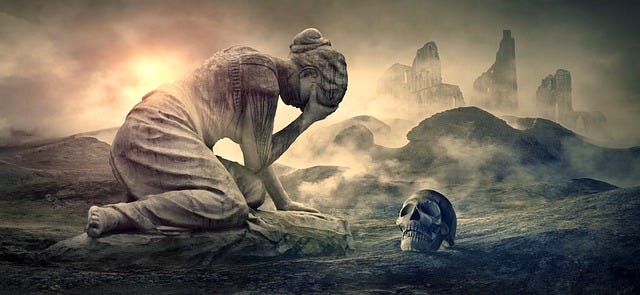Creating the Webbd Wheel: Toxic Shame and Forgiveness
In which we consider a mother who murders her children ...
The themes of shame and forgiveness occupy a lot of space in my experience. Guilt is the fact of having done something wrong. Shame is a painful feeling of having done something wrong. Guilt is remediated by taking responsibility for our choices and actions and making amends, as best we can.
Shame can become toxic. If we are chronically shamed when we’re young, especially for things we have no power over, like the color of our eyes or personality traits, we develop a belief that we’re loathsome and there is no remediation for it. We were born wrong and ugly and we can never be anything else. We live with toxic shame that gradually overwhelms our thoughts and feelings, our physical appearance, our choices, and especially all our imperfections and mistakes, perceived and real. We’re never free of it.
Guilt is a healthy response to acting against our own integrity or social rules and laws, a message from our conscience to ourselves. Guilt motivates us to behave differently. Toxic shame is unhealthy and drains our power.
Often, guilt and shame overlap, and this brings me to the content of post #9 of the The Hanged Man. What do we do when we’ve committed some truly terrible act we can’t fix, like killing our children? If we live through the act and its aftermath, how do we manage our guilt and shame? How do we manage forgiveness?
Forgiveness occurs in two arenas. The one we’re most focused on is the forgiveness of others. Many of us don’t feel we deserve any forgiveness for our wrongdoing or wrongbeing, real or imagined. We don’t ask for forgiveness, and we have a hard time accepting it if it’s extended, although we secretly long to be forgiven.
It’s in the second arena, that of self-forgiveness, that the real power lies, however. If we can’t forgive ourselves, naturally we resist accepting the forgiveness of others. Ultimately, we can’t control whether others forgive us or not. The only place we have power is choosing whether or not we forgive ourselves.
It sounds simple, but it’s not. Forgiveness arises out of love and compassion, and if we have not learned to love ourselves, we cannot forgive ourselves and shame grows unchecked. We enter a downward spiral of self-loathing and self-destruction.
La Llorona, the Weeping Woman, is a character out of Mexican folklore who drowned her children and herself out of despair. It’s a beautiful oral story I told for years and was well-known in Latino-influenced Southern Colorado where I lived. I always wondered what happened to that woman after the story ended, and every time I read of desperate mothers destroying their children I think of La Llorona, who I named Maria.
How does a person go on after an event like that? How do we understand mothers who destroy their offspring? What kind of despair and desperation leads to such an act? How do we manage our thoughts, feelings, judgments, fears, shame and guilt, both as observers and perpetrators?
Are some things unforgiveable?
These questions and many more underpin all my writing. In Harvesting Stones, I take them on intellectually. In the Webbd Wheel series I take them on creatively.
I don’t pretend to have any answers to these questions. There may not be answers. But I can, via empathy and my own experience of guilt, shame, and forgiveness, imagine how it might be, how it might feel, what might happen.
So I did.
(This essay was published with post #9 of The Hanged Man.)


